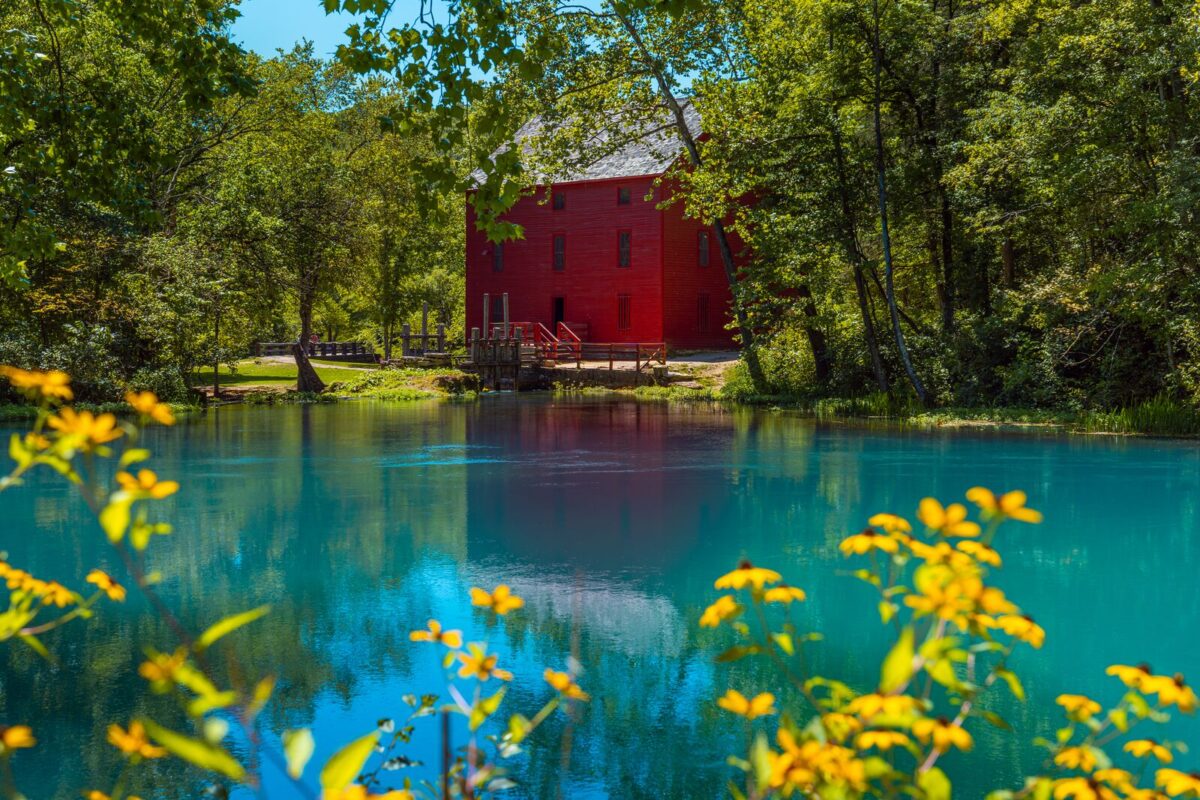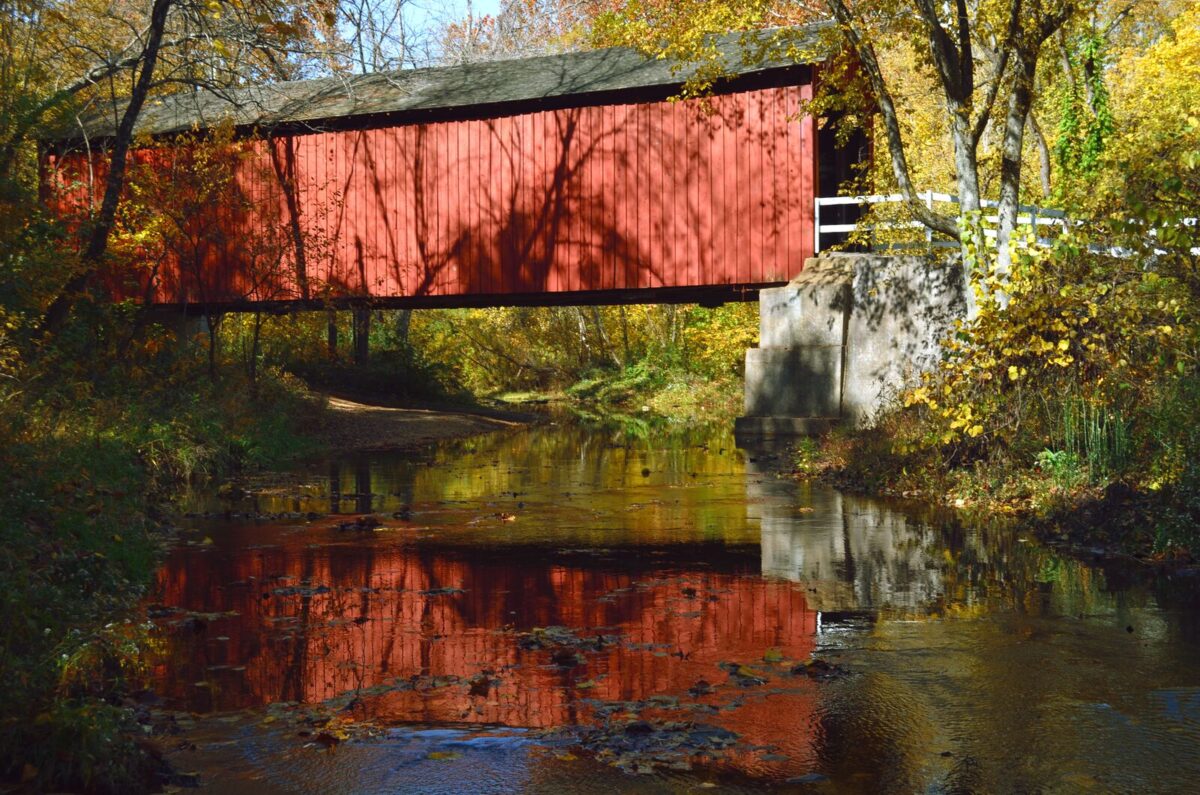When the sun hits Alley Mill just right, the reflection in the nearby spring stops hikers in their tracks. The image of the towering red structure on the teal blue water is striking.

Located a short distance from the crystal clear waters of the Jacks Fork and Current rivers in the south-central Ozarks, a lush oak and pine forest surrounds the mill. Said to be the most photographed spot in Missouri, the site – part of the Ozarks National Scenic Riverways – is part of the U.S. Mint’s America the Beautiful Quarter collection.
A short trail circles the spring and is the best way to fully experience the view. The spring – the seventh-largest in the state – pumps out more than 80 million gallons of water every day. Inside the two-story structure you’ll find National Park staff and displays that provide information about the vital role mills served in Missouri communities more than a century ago. An old one-room school house, general store, picnic area and campground are located nearby.
Natural beauty and history intersect at dozens of mills across Missouri. Many are under private ownership and serve as homes or rustic lodging for visitors. Others are part of the state and national park systems and are open to the public.
Historic Mills You Can Explore in the Show-Me State
Bollinger Mill
The massive four-story Bollinger Mill stands adjacent to the Burfordville Covered Bridge, one of just four covered bridges remaining in Missouri. Located on the Whitewater River, the stone-and-brick mill dates back to the Civil War era. Year-round tours explain how area farmers relied on the mill to grind their wheat and corn into flour and meal. The Bollinger Mill State Historic Site has picnic areas and hosts special events, including folk music concerts and Halloween storytelling around a bonfire.
Dillard Mill
Another of Missouri’s picturesque red mills, Dillard Mill, is one of the state’s best preserved grist mills. Most of the machinery used to grind wheat into flour is still intact inside the mill, built in 1908. Located on Huzzah Creek, the Dillard Mill State Historic Site offers fishing, hiking and picnic areas. Tours of the mill are available throughout the year.
Falling Spring Mill
In the middle of the Mark Twain National Forest, Falling Spring forms a small waterfall as it pours out from a rock bluff wall. Falling Spring Mill sits at the edge of the spring-fed pond. The waterpower harnessed by the mill, built in the 1920s, was used to produce electricity, grind corn and saw shingles. A wooden walkway leads to the mill, which still has some of its original machinery in place. The grounds include a small picnic area and a historic log cabin.
Hodgson Water Mill
In addition to grinding grain, the water power produced by Hodgson Mill operated a cotton gin, lumber mill and clothing factory. The bright red three-and-a-half-story structure, built against a tree-covered bluff, dates back to 1897. A spring emerging from under the mill spews more than 20 million gallons of water a day into Bryant Creek where ferns, moss and watercress thrive along the edge of the stream. Before the days of air conditioning, the spring-cooled air made the site a popular location for neighborhood dances. The mill is privately owned but can be viewed from roadside.
Watkins Woolen Mill
Many of the buildings constructed by Waltus Watkins during the 1800s – including a three-story brick mill and eight-bedroom Classic Revival home, are preserved at the Watkins Woolen Mill State Historic Site to give visitors a sense of what life was like in the 1870s. The mill – where sheep’s wool was spun into yarn and woven into cloth – is the only 19th-century textile mill in the United States that still contains its original machinery. A wood-fired boiler powered a steam engine used to operate the mill’s looms. Tours and a visitor center tell the story of the Watkins family and their many business ventures. Watkins Mill State Park has a 100-acre lake, paved bicycle path, fishing, campground and picnic area.
Find More Rustic Charm in Missouri’s Covered Bridges
An estimated 30 covered bridges once spanned many of Missouri’s rivers and creeks, providing vital links to travelers. Today, Missouri’s four remaining covered bridges only serve as reminders of days gone by. Although there were many advantages to the shelter with the roof and sides, the main purpose behind covering bridges was to protect the intricate structural network of iron and timber trusses from the weather. The coverings also added strength, which reduced sagging and listing. Riders in uncovered buggies and carriages often used the bridges as shelters from the wind, snow and rain.
Bufordville Covered Bridge
Burfordville Covered Bridge, located within Bollinger Mill State Historic Site, is the oldest remaining covered bridge in Missouri. Joseph Lansmon began its construction in 1858. After the Civil War, the bridge became a vital link, especially to farmers driving wagonloads of grain destined for the mill.
The bridge exhibits Howe-truss construction, named for William Howe, who patented the design in 1840. The essential feature of the design was its use of vertical iron rods to draw the diagonal wooden members tight against the top and bottom of the truss. The Howe-truss span was built mainly of yellow poplar. Burfordville Covered Bridge, which spans the Whitewater River, is 140 feet long and has a clearance 14 feet high and 12 feet wide.
Locust Creek Covered Bridge
At 151 feet, Locust Creek Covered Bridge is the longest of Missouri’s four surviving covered bridges. It was built in 1868 and became a link in one of the nation’s first transcontinental roads, Route 8. The bridge was made of white pine using the Howe-truss system. The essential feature of this design is the use of vertical iron rods to draw the diagonal wooden members tight against the top and bottom of the structure. In 2025, Locust Creek Covered Bridge was moved to the day-use area within Pershing State Park.
Sandy Creek Covered Bridge
Sandy Creek Covered Bridge, located in Hillsboro, Missouri, was constructed by John H. Morse in 1872 as part of a countywide building program in Jefferson County following the Civil War. After taking a stroll across the bridge, visitors can learn more about the history of the bridge on the outdoor interpretive display, then sit and enjoy a picnic lunch in the shaded picnic area near the bridge. The red barnlike appearance of the bridge and the natural setting surrounding it make an ideal scene for photographs or paintings.

Union Covered Bridge
Union Covered Bridge, built in 1871, is the only one of the four remaining covered bridges that represents the Burr-arch truss design. It served travelers in Monroe County for 99 years and is a peaceful spot to visit or stop and relax. The bridge is located in picturesque Paris, Missouri, and is a perfect place for pictures.

